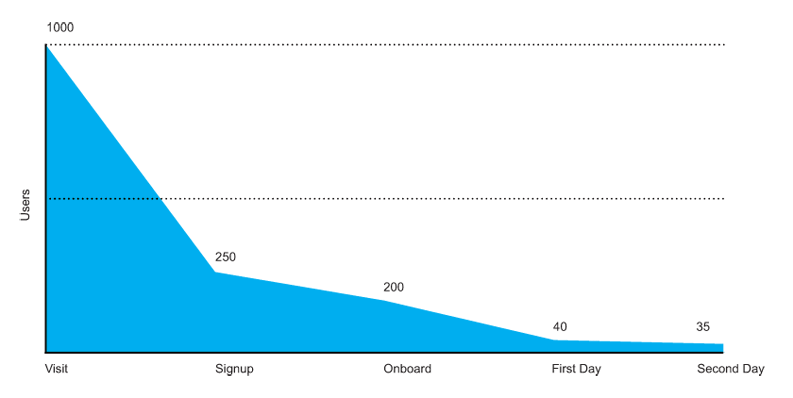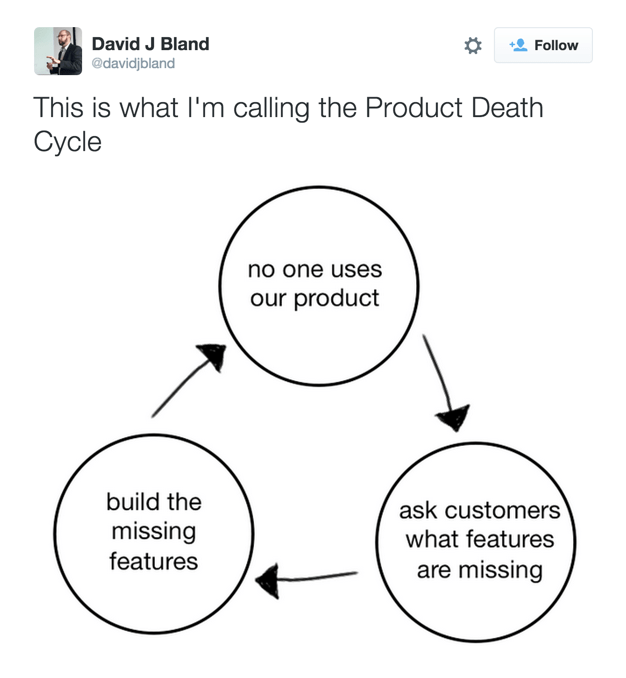-
How to Avoid Building a Feature No One Wants
Thu, 5 May 2016, in Customer Feedback
Henry Ford once said, “If I asked what people wanted, they would say faster horses”.

On the surface, it ignores modern market dynamics, the concept of customer feedback or the importance of early adopters during feature implementation.
If you’re an innovator in your industry, you should already have an understanding of customer needs through observational or statistical data methods. And if that’s the case, you’ll also ignore the majority of customer input and adhere to your vision without a second thought.
What’s more, taking everything your customers say to heart can throw you off track. And if that’s the case, it can disrupt your ability to make sound decisions and grow your business in the right direction.
For those of us who live to build ground-breaking products, it’s difficult to admit that something is simply not working, throw everything out and start from scratch.
People don’t want to hear or say “no”. So instead of saying they don’t want to use your product, they’d rather chalk it up to a missing feature than think of reasons why they don’t need it. Now, the best possible thing you can do is implement this feature because as far as your customers are concerned, it’s a win-win situation for both of you.
Except that it’s not.
In the real world, either people “get” what you’re building and selling or they don’t. It either fits their needs or it doesn’t – and there’s no magic fix or formula to change their mind.
Furthermore, whether or not someone “gets it” is heavily dependent on their onboarding experience. If that feature is (or will be) an integral part of your onboarding or marketing communication, it may make sense to add it.

It’s common knowledge that among many users who are registering to use your product only a fraction decides to stick around after the onboarding experience. This is partially why it’s so tempting to get your product just right. “If only I could add that new feature to boost the number of people that would stick around,” – you think – “All my problems would disappear.”
To understand why so many people wrongly believe that the “feature is the answer”, going so far as to equate features with sales, we must look no further than “the product death cycle”.
The product death cycle
It seems as if every lofty feature-building dream is driven by the right intentions: listening to what customers want and building it. But as mentioned before, it’s also easy to get blindsided by your customers.
Two years ago a San Francisco-based management consultant David Bland published a tweet that generated thousands of retweets – possibly because the issue resonated with so many. With a simple diagram called the Product Death Cycle, he demonstrated the importance of choices we make when it comes to customer service decisions:

Let’s look at this image in more detail:
- We start off with a problem: no one’s actually using your product. While there are many solutions to this problem, picking the wrong one will take you further into the “death cycle”.
- Asking customers for feedback is tricky because whilst we can learn a lot from our customers, the way we interpret and act on feedback can throw us off course.
In addition, we can’t expect users to come up with design solutions to our problems. Be prepared to listen to solutions that apply to their unique circumstances. - Time to celebrate, right? Wrong. That swanky new feature release may not have the effect on engagement you anticipated. It may attract too few users for the feature to be profitable. Or – your feature may be more attractive to engaged users than new ones – a sign that it may not positively impact conversions.
Yet despite all this, there’s a lingering possibility that your customers may not know what they want. They may need more time to trial your product before making a purchase decision. They may not even need your product at all, in which case you’ll need to know how to kindly show them the door.
Understanding the missing feature syndrome
Also known as the “perpetually missing feature syndrome” or “next feature fallacy”, it’s a mistaken belief that the next feature you create will make people use your product. This type of thinking is prevalent because it’s a lot easier to start developing features than to perform painstaking customer-facing research. But that’s just one of the caveats – here’s what else to watch out for:
- Not gathering feedback correctly / not asking the right questions. Mixing up customer “wants” and “needs”.
- Adding features “just because we must” is an assumption that more features will solve whatever problem your business is facing.
- Inability to engage using a community. Not able to accurately predict changes in the user experience the new feature will bring.
- Failing to communicate with users during the feature development process and keeping timelines hidden from users.
Going ahead with your feature
When rolling out a new feature, do you effectively educate your customers about the value it offers to them?
It’s crucial that new users can easily notice, set up and activate your product. However, your onboarding process largely depends on your product. For a social media site, it may involve following other users. For a blogging platform, it may mean setting up a theme and writing the first post. For a SaaS business, it may mean getting the customer to brand their account and walking them through the main functions.
Display your newly developed feature wherever possible: on your site and in your app.

Now you can pat yourself on the back!
If you’re a startup or a small business, getting your (however small) feature realized can place a noticeable burden on your resources. Once your team gets busy, it may be too late to backtrack and revisit the possibility of the feature not meeting projected adoption rates or positively impacting your growth curve.
At most – you’ll get a painful lesson out of it.
Where Henry Ford messed up
It’s important to link customer needs to your product development process. After all, it’s only after customers see a product that solves their problem that they decide to pay for it. It’s these crucial needs that open the floodgates to new sales and markets.
While Ford may have been lucky in taking the spotlight with the Model T as America’s favorite car, sales nosedived in the second half of the 1920’s. By then, the nearly 20-year old Model T was showing its age and no price slashing would change that. Meanwhile, General Motors was introducing a series of innovations for its models and easily surpassed Ford in sales.
If you don’t want to get gobbled up by a competitor, don’t focus on what features your customers want. Instead, try to understand the problems they face. Since your customers aren’t experts on complex features and user experience solutions, asking for their input will yield answers just as abstract and devoid of any substance. In other words, they won’t give you a good answer because they haven’t fully grasped their problem yet.
Why not spend time selling your product to those who need it rather than implementing the missing features for those who won’t buy it in the first place. Better yet, commit to implementing features if they come from engaged, paid users. If it’s truly a life-saving feature, you’ll have all the more reasons to build it.
Tags: customer feedback



